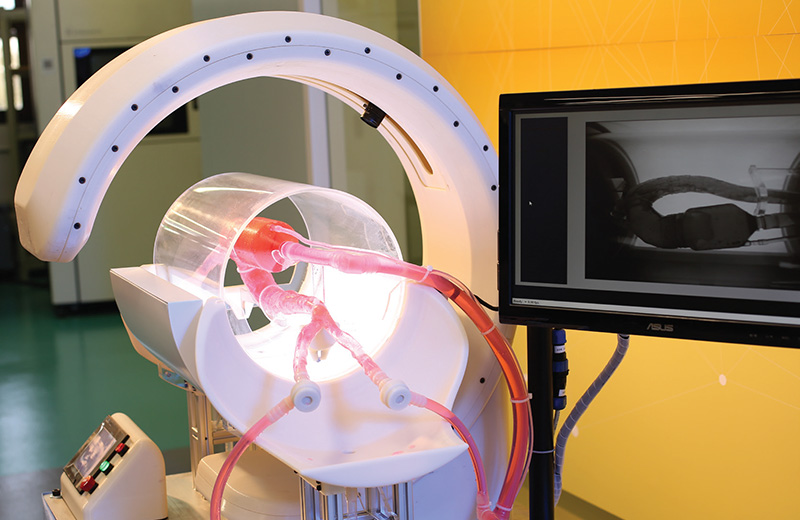
Demonstration of the Transcatheter Aortic Valve Implantation simulation model
Benefitting the community
The extent to which PolyU’s 3D printing expertise can benefit sectors of the community has already been shown in the field of healthcare. Hospitals, for instance, are embracing the use of patient-specific 3D printed models to allow surgical planning and trial runs, more general education and training, and medical device prototyping. In these areas, PolyU is a pioneer, having developed a Transcatheter Aortic Valve Implantation (TAVI) simulation model in collaboration with Queen Elizabeth Hospital (QEH).
Described by Prof. John Leong Chi-yan, Chairman of the Hospital Authority, as “a made-in-Hong Kong technology that benefits our patients and helps train our doctors”, the TAVI model was designed to allow the simulation of a minimally invasive procedure that replaces open-heart surgery with the repair rather than replacement of the aortic valve. Given the heightened risks faced by the elderly during openheart surgery and the ageing population around the world, this advanced approach to training is an important step in enhancing the quality of healthcare both locally and globally. It also benefits practitioners in that no X-rays are involved in the simulation, unlike traditional methods.
Working with simulation training experts and cardiologists at QEH, the team at PolyU put their expertise to work in developing a model that accommodates life-sized, 3D printed blood vessels and aortic valves based on patients’ computed tomography images. The model imitates human circulation in terms of fluid flow and temperature, and has a built-in rotatable camera and a screen for displaying real-time black-and-white images. This has obvious benefits in general training and preparing clinicians for specific surgeries, honing their skills early and extensively, enhancing teamwork and shortening procedure times. It can also be valuable in allowing the repetition of failure cases to determine what can be avoided in the future.
Earlier in 2017, QEH put the model to work as part of the first offering of a Hospital Authority sponsored Transcatheter Cardiac Intervention Training Course that attracted 18 doctors and nine nurses involved in high-risk interventional cardiac procedures from all public hospitals in Hong Kong. The feedback received was that the TAVI model is very practical and that 3D printed models have the potential to greatly enhance the medical training experience.
With the opening of the U3DP, and the Hong Kong government’s public support for Industry 4.0, PolyU’s teaching, research and development related to 3D printing and the many solutions to real-world problems it offers are set to take centre stage in a new era of technological advancement. ♦

The simulation model allows medical practitioners to have repetitive trials of the surgical procedure, utilising patient specifi c 3D printed blood vessel and valves of diff erent sizes.

